
Alicia, Birthday 2015, Chinook, WA
As a professor and a pedagogical expert — it’s my day job — I’m constantly pondering what I need to do to make my classes more effective for more of my students. I mostly just run my Industrial Design Clinic (IDC) now, which is the capstone class for engineers in my department — the School of Mechanical and Materials Engineering. As I’ve mentioned in the past, I go out and solicit projects from industry and NGOs, and the students are required to complete them in order to graduate.
The IDC started small — I used to have two sections of 15-18 students a semester. But for lots of complex reasons, we’re now graduating far more. Last semester, I had 90 kids working on multiple projects. Needless to say, it can be very taxing dealing with so many, and in order to maintain the individual performance of all the students, I have had to evolve. People ask me what it’s like, and I complain, because it is indeed exhausting. I tell them I’m either a Deist God or the Pope, which are actually interesting mental models that describe how I do what I do.
As I collect the projects for the class, the sponsors are also given meta-scripts about how they are to deal with the students. For example, the typical relationship for an externally funded and acquired project is the person on the outside in industry should act like a mentor. I tell them they can’t do that — they have to act like a customer. But it’s a self-aware customer, and since most of them are engineers, and many are also ex-students, they know that the limits of the role. The idea is that if the students really stumble, they can shift back to mentorship, because we all want the kids to get the work done. That’s the Performance v-Meme goal.
By being the Deist God — or more descriptively, the Watchmaker God, I set up the world. And then at the beginning of the semester, I hit the start button, the students are dumped into the world, and the watch runs. In Deism, there’s a distinction between a ‘cold’ God and a ‘warm’ God — completely non-interventionist vs. modestly interventionist. I’m definitely on the ‘warm’ side. Of course, the sponsors and I talk (they’re usually my friends by this point.) But since the world I’ve set up for the class is pretty much complete, my expectation is that by the middle of the semester, I’m going to be a ‘cold’ God again, and they will be independent of me save for some university paperwork and constant encouragement.
The other analogy I use is I call myself the Pope. Pause for a minute and reflect on what you might think that means — it will tell you a lot about your own v-Memes. Divine authority? Only channel between people and God? Not so much. I tell people, when you have 45 kids in a lab session, they line up and supplicate themselves to you for favors. I respond in kind — “can I wash your feet? Bless your baby? Give some charity? Sign your P.O.? Say two rosaries and three extra Our Fathers, and God will hear your prayers.”
These two representations map to the Global Holistic/Turquoise (the Deist God), and the Bodhisattva/Coral v-Memes. My student evaluations have never been higher. But since I’m not actually that evolved myself, it’s pretty exhausting. I have to stretch. Still, the class is tremendously successful, and much of the rumination on this blog is based on why this strange thing I’ve set up works. And it sets up fertile soil for applying others’ insights to my own operation.
For example, lately, at the behest of one of my collaborators (shout-out to Ryan!) as I mentioned a couple of posts back, I’ve been listening to Daniel Siegel’s audiobook, The Neurobiology of We. Siegel’s work as a psychiatrist is mostly centered around healing trauma. In order to do that, he preaches his version of the concept of integration. Using a soft version of the left-brain and right brain understanding of the brain, he differentiates this into discussing how the left neocortex and right neocortex — the big, thinking cap that wraps itself around our limbic/emotional system– operates.
Siegel assigns the primary function of the left-brain neocortex to storing and processing explicit knowledge — in his words, the fragments of events and such that the brain receives from the various sensory organs (sight, sound, etc.) and body parts that receive the stimuli from given events, as well as trauma. He then assigns the primary function of the right-brain neocortex to a holistic, experiential interpretation and integration of those pieces of information on the left. The integrator is the hippocampus — part of the limbic system that sits between the two and serves important roles in short term memory, and has recently been shown to have interesting effects in spatial and temporal regulation. 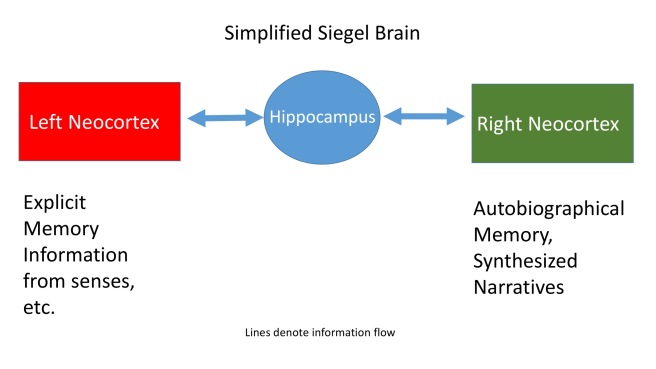
Simplified Siegel Brain — how integration occurs
All of this assembles our autobiographical memory and synthesized narratives. The hippocampus, this complex part of the limbic system with spatial and temporal scaling functions (now does that sound like an empathy-driven subsystem or what?) creates these linked memories. You have to have stuff on the left in order to make those more complex, synthesized structures on the right. That’s important to note. But in any normal day, the hippocampus is there, doing that processing. Siegel doesn’t mention it, but I’m sure sleep is also an important part of this.
In Siegel’s explanation of trauma, these three parts, when they don’t work, or integrate information together, create the sadness and potential mental illness that many suffer from. Fair enough. I’d argue that in order to expand our understanding of trauma, as well as education, we need to add the effect of the amygdala, the part of the brain originally thought responsible just for fear, but turns out to have all sorts of other functionality. In our modified Siegel Brain model, the amygdala serves as a switch, modulating the function of the hippocampus. 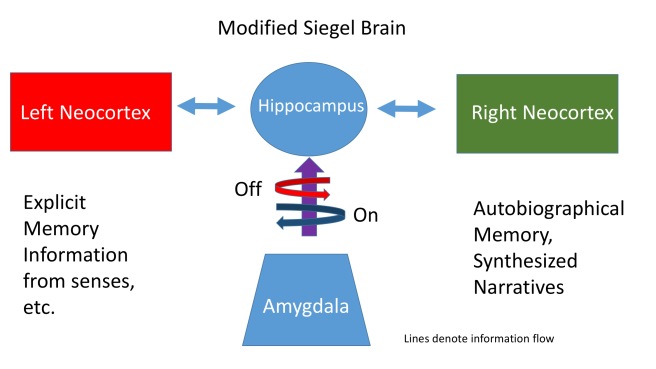
When the amygdala is on low alert, the hippocampus goes on its merry way, taking in that explicit memory from the left neocortex, and shipping it off in narrative memories to the right. Did that pie at the bakery that you just smelled remind you of your last Thanksgiving with your favorite Grandma? That’s just the hippocampus and all the happy parts of your brain doing their thing. Or if we had to get fancy with language, the hippocampus forming a neural chain across the neocortex, through the corpus callosum, making a synthetic persistent memory that reinforces cognitive bias toward cherry pie!
But an interesting thing happens when, all of the sudden, you are attacked, or upset. The amygdala springs into action! It shakes the hippocampus by its lapels, and says “Stop, you stupid hippocampus! We’re gonna die! And we need every bit of attention and focus of that short time-scale impulsive function right here!” So it shuts off that process of transfer.

Trauma itself is an interesting biochemical phenemenon, one that we’ve discussed a little bit in the rest of the blog, and is in itself the subject of much study. We know that good old fashioned adrenaline gets squirted into the system. That can give us super strength when we need it. And then there’s cortisol that’s produced, that speeds up sugar metabolism, for increased energy (flight, anyone?) as well as slowing down inflammation (let’s get those muscles in top shape so we can get out of here!) I’ll also speculate that the sensory overload backs up creation of any kind of coherent fragments in the left neocortex, and that’s gotta mess with the brain as well. Think of overheating your computer.
Psychiatrists and psychologists have various remedies for reversing this back-up of stimuli and getting toward homeostasis in the brain. Not treating trauma leads to continued Post Traumatic Stress Disorder, and a host of physical ills. There’s tons more to discuss, and I’ll just recommend that you listen to the rest of Dr. Siegel’s book.
How can we map this to the educational space? The main takeaway I’d argue from The Neurobiology of We is not just that the insights just apply to trauma. They also map to how we attempt to educate people. If you ask any professor what their eventual goal with respect is to students’ education, they’ll almost always say “Critical Thinking”. Here’s as good a definition as any:
| Critical Thinking as Defined by the National Council for Excellence in Critical Thinking, 1987
A statement by Michael Scriven & Richard Paul, presented at the 8th Annual International Conference on Critical Thinking and Education Reform, Summer 1987. Critical thinking is the intellectually disciplined process of actively and skillfully conceptualizing, applying, analyzing, synthesizing, and/or evaluating information gathered from, or generated by, observation, experience, reflection, reasoning, or communication, as a guide to belief and action. In its exemplary form, it is based on universal intellectual values that transcend subject matter divisions: clarity, accuracy, precision, consistency, relevance, sound evidence, good reasons, depth, breadth, and fairness. |
||
| It entails the examination of those structures or elements of thought implicit in all reasoning: purpose, problem, or question-at-issue; assumptions; concepts; empirical grounding; reasoning leading to conclusions; implications and consequences; objections from alternative viewpoints; and frame of reference. Critical thinking — in being responsive to variable subject matter, issues, and purposes — is incorporated in a family of interwoven modes of thinking, among them: scientific thinking, mathematical thinking, historical thinking, anthropological thinking, economic thinking, moral thinking, and philosophical thinking. | ||
What can Siegel’s model of how the brain processes information from Left to Right help us understand and educate for critical thinking? We really want that holistic, integrated understanding of various subjects, because that enables the agency of the owner of the knowledge to act on that knowledge — be it in their profession, or choices made in their personal or political life. But what are we actually doing in education? Here’s a modification of Siegel’s brain applied to a typical lecture-based classroom:

Sage on the Stage
Our professor is now giving a lecture. And trust that most professors do care about student learning, and craft what they deliver so that they think students can understand them. They don’t want the students to be afraid in class (well, mostly) but they do want the students to walk away with a corrected, coherent picture of what they were supposed to learn from the syllabus. They’ve got to follow the syllabus, essentially an externally imposed calendar, and that is a big deal — we use it for accreditation, and checking up on each other as well as the students.
Using Siegel’s model, we can see the flaws in this. The individual student is sitting in class, with information flowing toward their Left Neocortex. Not much time to synthesize in any autobiographical context, because Mr. Hippocampus would tell you that this takes time. That’s the purpose of the homework, any professor would tell you, or the idea of doing the readings BEFORE you come to class. Flip that classroom! Get those kids to be responsible!
The reality is that the sensory stream (or lack thereof) in the lecture is only incompletely being received. And that is contaminated by the fact that it’s the first sunny day in a week, and the young women are wearing short dresses, or the guys are in muscle shirts inside the classroom. Or the professor is telling the same stale jokes, and there are other assignments in other classes, or maybe the student has a job serving slop in the dining hall. The upshot? Incoherence in the input stream, as well as a lack of agency and time in the final, synthesized version that ends up in our holistic interpretation dramatically impedes initial learning AND retention. And because there’s very little attempt toward autobiographical mapping (you need to read this text because it’s IMPORTANT!) the information structure formed in the Right Neocortex is, well, weak, and not anchored very firmly inside the rest of the structure of memory. If it makes it across the corpus callosum, from Left to Right (and there’s no guarantee it will make it that far,) it’s due to be core-dumped from the Right side after the test.
And then there’s good old Amygdala sitting there in the student’s brain, turning Hippocampus on and off anyway, as the fear creeps up in their throat when they realize the professor is looking for someone to ask a question. It’ll be a trick question, because the professor is mired deep in their Legalistic v-Meme, which says completeness is the most important thing, and what better way to establish status over these ignorant students than to show them the real breadth of knowledge they’re supposed to know? There’s only 300 of them in the room. Always good to get the rest to pay attention — throw one of them up against the figurative intellectual wall. Forget that the WAY the professor is getting the students to pay attention is by using a trauma response, which sends adrenaline and cortisol into the brains of all the kids who are paying attention, shutting down their hippocampal synthesis process. And so on. Nothing like getting to see the ‘Freeze’ response in action!
So let’s see what the Siegel model looks like in traditional engineering education.
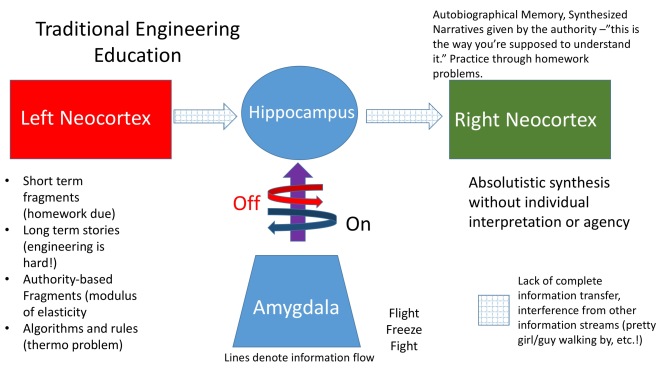
Pretty much the same. But I’ve added a little detail. Now we have the knowledge structures that come from the social/relational structures typically associated with the v-Memes of engineering professors. We’ve got everything from Survival information (when are we going to have the next test? When is class over?) to more complex algorithmic processing (calculating the internal temperature of a boiler.) You have to teach this stuff — without basic algorithms for solving engineering problems, your kids are not going to get far. And there can’t be any interpretation. Enthalpy is enthalpy, after all.
But no matter how well-meaning all of this is, it’s unlikely to result in students being able to use the material. The information flow is one-way. And you still have the problems with overall information corruption. While you can get past that with repetition and drill, there’s still going to be a piece missing — the autobiographical synthesis. Once again, the knowledge, if it makes it across the corpus callosum, will be only weakly tethered to personal experience and agency. And as such, it won’t be the first tool in the toolbox the students reach for when confronted with a ‘real world problem.’ There’s simply no autobiographical context/neural connection to move it off the textbook page.
So, let’s step up our game. Let’s now look at Active Learning in the context of the Siegel model.
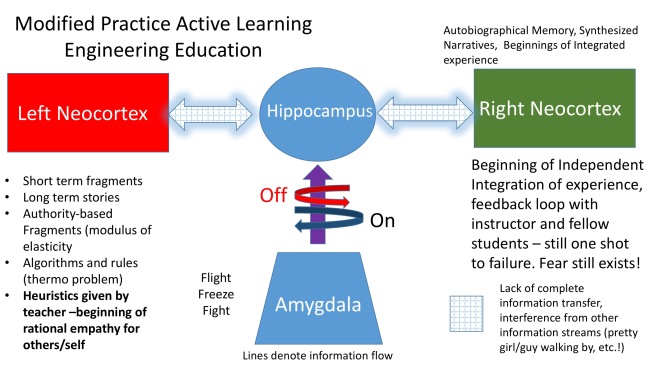
We’re starting to see a little improvement. Now we’ve given the kids a problem to solve, and we’ve also introduced some back-and-forth possible in information flow. Students, in the context of solving the problem, can do some cognitive laps between Left and Right, asking for details on how to solve a part of the problem. They’re gaining some experience, because they’re likely working in teams, so they’re sharing information and also triggering different empathetic mechanisms. Now that we’ve got a little agency, students can use some heuristic paths in solving the problems, so they’re activating their right brains in pulling out autobiographical memory. We still have the base level scaffolding required in the Left Neocortex — see the list of knowledge structures that, of course, map to the relevant v-Memes.
But it’s still one-and-done. There are twenty groups in the class, and if you’re a student, you don’t want to be with part of a group that can’t solve the problem. Old Amygdala is still there unless the professor has created special safety sidebars, getting ready to turn off those higher cognitive processes and turn on fear!
Can we step up our game even more? How about a little LEAN in education and our Siegel Model?
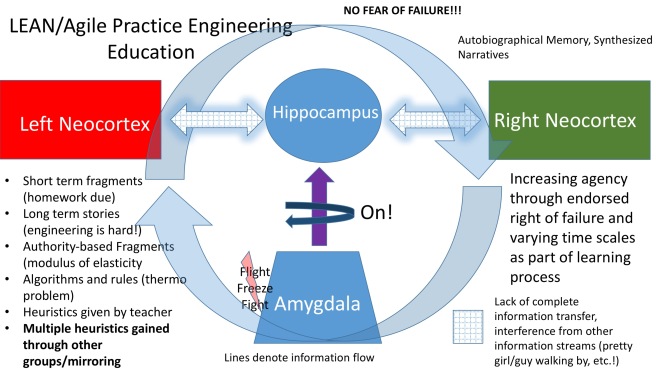
Now we’re getting closer! By emphasizing quick solutions first, leading to more detailed solutions later, and granted agency for project timescales, as well as the introduction of concepts such as scrums and sprints, we’re finally putting Amygdala to bed, and freeing that synthesis process across the Neocortex. All the Left Neocortex scaffolding is still there — we still need Young’s Modulus, and how to calculate the Coriolis force. But we’ve got some heuristics that the professor has given us, and on top of that, we can now look across the other groups and see what problem-solving modes they’re using. Now we’re really piling up the external empathetic modes as well — mirroring, rational place taking, as well as sharing the pain/ emotional empathy of trying to meet deadlines. Multiple loops of refinement are built into the process, and you already know that no one is going to get it right the first time. LEAN is built on several iterations toward a final solution. Agile has multi-faceted timescales, with scrums and sprints, empowerment at the conceptual level across the workforce, and rapid multi-level prototyping to get to a point of feedback sooner rather than later.
What’s the next step? What does reflective practice look like in the context of the Siegel Brain?
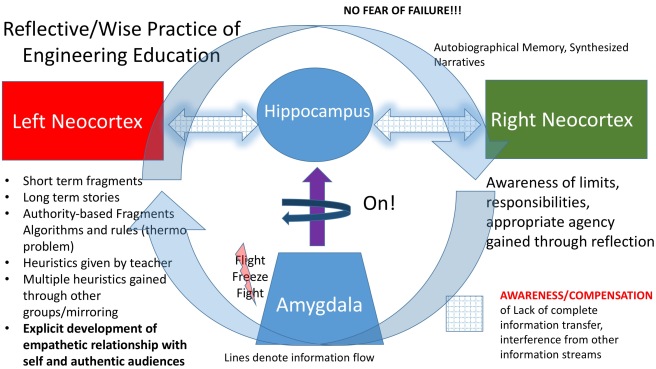
Now we’re aware of ourselves and our environment. We’re grounded in the outside world — what might be actually doable and valid. And through the integration of authentic audiences, we develop the ability to share larger meaning. Empathetic!
It doesn’t stop there — because the search for enlightenment never stops. But this is a start. It’s important to understand that we can’t do everything, always, at our Wise level. That’s the metacognitive awareness of wisdom talking. But we can structure our lessons so we know what our expectations ought to be. And how long they’ll stick.
I went to a future of engineering education conference tied to an Engineerers without Borders Canada conference. I have also worked with Peter Senge on bringing systems thinking into education via Camp Snowball. Both of these groups could benefit from such a wel anchored discussion on why this works and promotes healthy integration. Great job here
LikeLiked by 1 person
Thanks, Ryan! Do tell if I missed some a.) nuance from Siegel, or b.) point of credit. I did order the Pocket Guide, but the downside of a completely oral presentation from the Neurobiology of We is that it is not easily reference able. I tried to search for the actual hippocampus piece but couldn’t find it. And I do not remember if he discussed amygdala integration, but I’m pretty sure he didn’t. Spent four hours on those drawings — but I think they were worth it. They will serve as the basis for a change agent discussion with NSF next week.
LikeLike
Bloody impressive/ creative/ contextural book review
LikeLike
Great post. This reminded me of a recent paper titled “Hidden Stages of Cognition Revealed in Patterns of Brain Activation” (Anderson, Pyke and Fincham, 2016). The research team identified four stages of cognition: encoding, planning, solving, and responding. The summery indicate that the method mapped onto real stages of cognition that were differentially affected by various features of the problems. This may apply to a individual learner, where your post encompuses multi-agent learning.
Mike
LikeLike
Just an outstanding comment. The bottom line? Increase your own agency, responsibly, and your learning will also increase. Like Pee-Wee Herman would say, “Spirally!”
LikeLike
Great text and reflection!!
It is really on the edge of what education should and will look like in a near future.
This reminds me of Lonnie Wilson’s book “Sustaining Workforce Engagement” where positive encouragement, amongst others, is fundamental, and giving some freedom (even to fail) to collaborators can bring several benefits. If we reflect on it, the same concepts could be applied in class, since we do want engagement from students so they can perform well on their learning process achieving the so desired critical thinking.
LikeLike
Luiz — this is the format for the last 20 years.
LikeLike